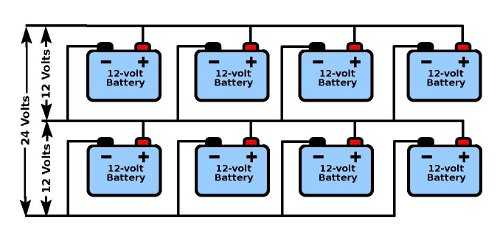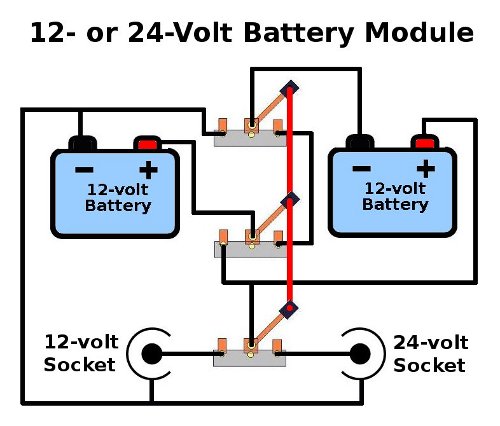
by John P. Pratt
14 Apr 2017, 7 Condor (SR), End Passover (E), End Transplanting (J)
©2017 by John P. Pratt. All rights Reserved.
| 1. Problem 1: Mix & Match 12 & 24 Volts |
| 2. Problem 2: Sunny or Cloudy? |
| 3. Solution: Mix & Match Modules |
| 4. Conclusion |
| Notes |
Sometimes problems arise for the handyman who is cobbling together a homemade solar power system from parts bought on sale which are mismatched. For example, most solar panels are 24-volt but one may wish to power 12-volt equipment directly. Wouldn't it be nice to have a battery with a switch on it to convert from 12 to 24 volts? What about needed flexibility to switch from daily sunny weather operation to survival mode in cloudy weather when there is no other source of power? This article presents a solution to these problems based on dividing the entire system into small modules which can be connected in a variety of ways to meet different needs as they arise. And in fact, it is shown how to connect a knife switch to two 12-volt deep cycle batteries to convert them back and forth into one 24-volt battery.
Can 24-volt solar electric power panels be used to charge 12-volt deep-cycle batteries without an expensive power controller which converts 24-volt power to 12-volt? The main purpose of a simple controller is to keep from overcharging the batteries. A controller is not needed if one is using the system such that the batteries could never get overcharged. I have a friend who has a working system who uses his refrigerator as a controller because that never lets his batteries get fully charged!
The obvious solution of using 12-volt panels to charge 12-volt batteries is only done on very small systems such as with motor homes. There are two problems with attempting to use 12-volt panels in larger systems: (1) 12-volt power loses much energy in traveling even 50-feet from the panels to the house and (2) 12-volt panels are more expensive per watt of output. For example 24-volt panels often cost under $1 per watt of output (250 watts for $200, or $0.80 per watt) whereas a 12-volt panel of only 100 watts costs about $140 ($1.40 per watt).
About three years ago I bought 8 typical 24-volt 225 watt solar panels. Before that when I had built my home, I wired into it four 12-volt circuits to run emergency lights, water pump, etc. I installed several 12-volt cigarette lighter type plugs around my home to use the many 12-volt gadgets that are available for trailer and motor homes. The reason for those circuits is that lights and most electronics run on 12-volts directly so it is more efficient not to convert to 110 volts and back. I also wired a couple of the regular 110-volt circuits to be potentially powered by solar power in emergencies to keep the freezer and some kitchen appliances running. That way I also have the option of always powering those circuits with solar power to isolate them from the main power grid (my main source of power) to prevent power surges from lightning or EMP destroying equipment.
Now the time has come to set up my system and the problem I'm facing is how to use the inexpensive 24-volt panels with those 110-volt circuits and also the 12-volt lighting circuits as well as charging 8 deep-cycle AGM 12-volt batteries.
The standard solution is not to mix and match so much. It is cheaper not to wire a home twice with both 12-volt and also the standard 110-volt wiring. The usual plan is to hook up all of the panels to an array producing either 24 volts or 48 volts and then run it through an expensive controller (at least $500) that changes the high voltage current down to charge a bank of 12-volt batteries.
 |
As final design was begun, it became immediately obvious why the solution shown in Figure 1 won't work. For simplicity to see the problem, suppose there are just two batteries as in one vertical column. If the 12-volt circuits hooked to the upper battery uses a lot of power and the lower one uses little power, then there will be real trouble. There will be only one charging current the passes through both of the batteries. Even with the best power controller, that current would over charge the lower battery while trying to fully charge the upper one. Those controllers need to charge an array of batteries that have all been equally drained so that the same charging voltage and current will work properly on all of them at once.
Thus, the essence of the first problem is knowing how a bunch of 12-volt batteries can be charged by 24-volt panels and yet be used to power 12-volt electrical circuits without needing an expensive controller. Before looking at the proposed solution, let's consider another problem which is at the heart of solar power design.
A serious decision confronting anyone designing a solar power system is to decide how many batteries to include to use stored power when the sun isn't shining. The problem is that if one wants to store enough power the keep the system running during two full weeks of rainy weather then so many storage batteries will be required that it will be hard to charge them all. Another way to say it is that if the solar panels produce only enough power to fulfill daily needs in sunny weather, then there won't be enough power left over to charge batteries for the stormy weather days. Typically the batteries only store enough power to last for a few dark days.
What about the idea of having two distinct modes of use: sunny and cloudy. During sunny weather the power could be for many everyday uses. But when it turns dark and a week of rain is predicted, perhaps a switch could be flipped to change to minimal power usage so that at least the very low energy lights could last a couple of weeks. It seems important to note that when we have power outages in this area it is usually during electrical storms when there is no sunlight at all!
Today finally these two problems were solved to my satisfaction. It is to set up the panels and batteries as sets of "mix and match" modules.
The first basic problem to be solved is how to charge the 12-volt batteries with 24-volt panels and also use those batteries to run 12-volt circuits without discharging the batteries differently. Again the usual solution is to use an expensive power controller to force the match, but ideally the problem should be solvable without a controller. After all, the main use of the controller is only to prevent over charging. So the challenge is to solve the problem without the use of a controller.
Surely others have solved this problem but no solution was found on my search of the Internet. Today it took some time to finally see the very simple answer which seemed important enough to share with others to save them time and frustration. The solution is simply to always use one pair of batteries together. When charging them with 24-volt panels or using them to power 24-volt equipment they need to be connected in series (plus to minus as the two batteries in each vertical column of Figure 1). When using them to power a 12-volt circuit they need to be hooked together in parallel (plus to plus and minus to minus as in each horizontal row of Figure 1) to make one double size 12-volt battery. Sharing that "secret sauce" is really what this article is all about.
 |
Similarly my panels will be connected in pairs in parallel to form one solar module to charge the battery modules (switched to 24-volts) with a maximum current of 15 amps (7.5 amps each). That way one solar module produces a good charging current for one battery module. Even deep cycle batteries should probably not be discharged much more than 20-30% during daily usage. A 120 amp-hour battery that is discharged to 50% would need 60 amp-hours to recharge which would take 4 hours with a 15 amp current. Thus, the 15 amp current from one module should be sufficient for most daily usage.
Another module will be a 24-volt inverter to produce 110 volt power for standard household circuits. That inverter can run directly from the panels or from battery modules or all at the same time. Thus one can limit use of higher power appliances to sunny days with charged batteries.
 |
Although the battery module was designed for possible use without a controller, there are many advantages to having one. In fact, you almost certainly will want an MPPT (Maximum Power Point Tracking) controller to connect the solar panel modules to the battery modules. If you have no controller, you lose much potential power. For example my panels are 225 watts being 7.5 Amps at 30 volts (30 volts x 7.5 amps = 225 watts). Two of those in parallel are used to make one of my solar power modules, so a module is 450 watts (15 amps x 30 volts). But if the module is connected directly to a 24-volt battery the voltage will drop to 24 volts and the current stays the same at 15 amps, so only 15 x 24 = 360 watts is produced. That is a 20% loss of power! All that a typical controller does is to stop the battery from overcharging. An MPPT controller not only prevents overcharging, but also increases the current to something close to 18 amps to get about 18.4 x 24 = 442 watts. That is only about a 2% loss of power instead of 20%! But what about cost of having to buy 4 MPPT controllers which each controls 15 amps rather than only one controller that handles 60 amps of current? It turns out the smaller ones are much less expensive! I just bought the one shown in Figure 3 for $88 to test it out. It works on 24volts and 15 amps, exactly what is needed. One that handles 60 amps usually costs about $450-600. So the modular approach is noticeably less expensive as far as the cost of the controller is concerned.
As for the sunny/cloudy problem, one can have extra sets of battery modules kept charged for rainy days but otherwise not in the system. That works well with not being able to charge the 12-volt modules while they are being used to power circuits. There will always be a couple of extra fully charged battery modules. All that is required on a rainy day is to plug a 12-volt circuit into one of the already charged battery modules.
The problem of using a solar power system which needs to employ 24-volt solar panels to service power 12-volt circuits is addressed by introducing "modules" which can be combined in many ways for great flexibility. The basic unit of compatibility is a battery module composed of two deep cell 12-volt batteries which can be switched to 24-volt for charging and powering 24-volt converters and to 12-volt for powering 12-volt circuits. This means that the both batteries in the 12-volt configuration will always use energy at the same rate so that they can always be charged together with the same current. The drawback to this system is that the batteries cannot be charged at the same time they are powering 12-volt circuits. The best features are that it is more flexible, less expensive, does not require matched parts (such as matched batteries) and does not fail when one part fails (such as one power controller for the entire system).